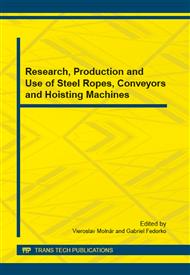[1]
A. Pavliskova, M. Andrejiova, Statistic evaluation of conveyor belt's lifespan using analysis of variance, Transport and Logistics Special issue 6 (2009) 277-281.
Google Scholar
[2]
M. Andrejiova, A. Pavliskova, Annalysis of regression model of functional dependency in impact force from height and weight of ram for conveyor, Annals of Faculty Engineering Hunedoara: international journal of engineering 8(3) (2010) 267-270.
Google Scholar
[3]
M. Andrejiova, A. Pavliskova, N. Husakova, Application of multi-criterion decision methods by the selection of optimal constructive elements for devices of continuous transport, in: Carpatian logistics congres, Ostrava, 2012: pp.1-6.
Google Scholar
[4]
D. Marasova, M. Cehlar, J. Jablonska, Mathematical modeling of hyperelastic materials, Transactions of the Universities of Košice 1 (2001) 18-25.
Google Scholar
[5]
D. Marasova, M. Cehlar, J. Jablonska, Determination of material's characteristics of conveyor belt by using Mooney-Rivlin's material model, Transactions of the Universities of Košice 1 (2001) 26-32.
Google Scholar
[6]
P. Bindzar, A. Grincova, I. Ristovic, 3D mathematical model of conveyor belt subjected to a stress loading, Podzemni Radovi 13(15) (2006) 179-188.
Google Scholar
[7]
P. Bindzar, D. Malindzak, Number of conveyor belts optimization regarding to its type and logistical parameters in mining industry, Acta Montanistica Slovaca 4 (2008) 524-531. (original in Slovak).
Google Scholar
[8]
Z. Bittnar, J. Šejnoha, Numerical methods of mechanics, ČVUT Praha, 1992. (original in Czech).
Google Scholar
[9]
A. Grinčová, A. Hlúbiková, J. Krešák, Methodology of conveyor belts testing by breakdown, Transport & Logistics Special issue 5 (2008) 209-213. (original in Slovak).
Google Scholar
[10]
D. Marasova, Mathematical and experimental support for belt conveyors, first ed., VŠB-Technical University of Ostrava, Ostrava, (2013).
Google Scholar
[11]
G. Fedorko, V. Molnar, D. Marasova, A. Grincova, M. Dovica, J. Zivcak, T. Toth, N. Husakova, Failure analysis of belt conveyor damage caused by the falling material. Part 1: Experimental measurements and regression models, Eng. Failure Anal. 36 (2014).
DOI: 10.1016/j.engfailanal.2013.09.017
Google Scholar


